![]()
By Sandra Stoner-Mitchell
Please read the other one. This was somehow posted twice and not edited or promoted!!
![]()
By Sandra Stoner-Mitchell
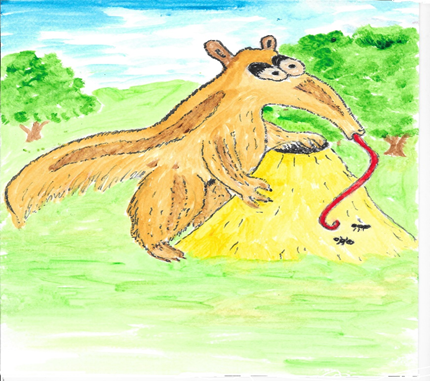
This is the second edition of my ABC book, totally new and updated. This time I've added many interesting facts about the animals as children learn about them. I discovered many amazing things about all of the animals I'm featuring. I hope you enjoy them too.
A is for Anteater
Anteaters are extremely large
they have a huge long nose.
Their tongues are long and sticky,
it drops down to their toes.
When they poke it into anthills
the poor stuck ants can’t run!
And then they’ll bring their tongues back in,
to swallow everyone.
Fun facts on Anteaters
Anteaters don’t move very fast and tend to shuffle along. Their paws have huge, knifelike claws, so long and sharp that they need to walk on their knuckles or wrists to avoid stabbing themselves.
They need these sharp claws to open concrete-hard termite and ant mounds. They eat about 30,000 insects a day, but anteaters only stay a few minutes at any one nest, taking just a few thousand insects from each. Although, as their name suggests, they do eat ants, their favourite dish is a big tongue load of termites. Yummy!
Anteater shuffle along, rather than walk; but when it comes to running, they gallop like a horse and can reach speeds of up to 50 kph, or about 31 mph. They’re also really strong swimmers and use their long noses like snorkels. What a clever idea!
The Silky Anteaters are the smallest in the world with the adult weighing anywhere between only 180 to 400 grams. They are around fourteen and seventeen inches in length.
While the Giant Anteaters weigh in between 40 to 140 kilos, and can reach up to between six to eight feet long. Starting from their breastbone, their tongues can be as two feet long. As soon as the ants are stuck on the very sticky tongue, it is pulled back in and the food is swallowed whole. Once in the stomach, the anteater's super-strong muscles will grind them up.
Silky Anteater Giant Anteater
These giant anteaters prefer to be alone. The females have just one baby at a time, which can be seen riding on its mother’s back. These are called pups and will stay with their mother for two years. This is when they are thought to be fully grown.
Giant anteaters can be found throughout South and Central America, while there are only around 5,000 giant anteaters left in the world, a small number, about 90, live in zoos. These amazing animals have been around for 25 million years. Let’s all hope they will be around for many million more years to come. For this to happen, they must be able to move around in huge areas with large patches of forest where there are masses of ants and termites.
Pictures by Pixabay
| Author Notes |
Facts researched on Google
The top picture is from Pixabay and the bottom one is my husbands creation. :)) I'm writing this for my grandson, Eric. (lol, who'd have guessed?) The first book is much too young for him now. |
![]()
By Sandra Stoner-Mitchell
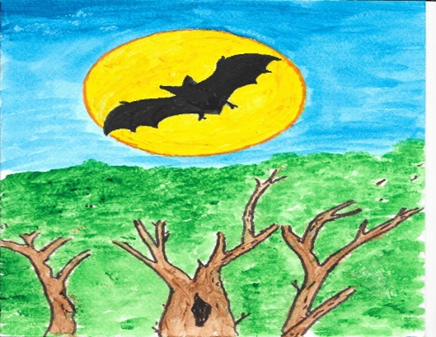
B is for Bat
Bats can see like you and me,
In fact their sight is sharper!
Sonar shows if danger’s close
So they have time to scarper.
Animals supply the blood
For Vampire bats to feed on
Other bats eat bugs or fruit
And share when it’s agreed on.
Fun Facts on Bats
A small bat can eat up to 1000 mosquitoes in just one hour, a large one will eat between 2000 to 6000. Bats will share food if they see others aren’t getting enough. Vampire bats will regurgitate blood for another bat.
Some bats now have a highly skilled sense of hearing. They send sounds that bounce off objects in their path, which then sends echoes back to the bats. From these echoes, the bats can tell the size of objects, how far away they are, how fast they are traveling and even their texture, all in a split second.
The largest bat is the Malayan Flying Fox. Its wings have a six foot span and they can weigh up to two pounds. The smallest bat is the Bumblebee Bat, also called the Kitties hog-nosed bat, it only has a span of six inches.
There are three types of Vampire bats, and they live in Central and South America, and Mexico. They fly at night and will only suck the blood from field animals such as chickens, goats, pigs and cows. They take a few drops of blood from each animal, stopping once they’ve drunk about one tablespoon full.
Bats shelter in nooks and crannies in trees, buildings and caves. Some species are solitary while others form colonies of more than a million.
One myth that is totally wrong is that bats are blind. They’re not; in fact the larger bat’s sight is three times better than humans.
Another fact is they can’t stand upright because they have a very small pelvic area and would overbalance. They hang upside down when they eat, drink and have chats with their friends. Yes, they socialise as well!
They are also the longest-lived mammal for its size with a life span of thirty to forty years and are the only mammal that flies.
In the UK, Bats are a protected species.
| Author Notes |
Research for Google.
Thank you for reading letter B in the alphabet. The top picture is from Pixabay, and the one at the bottom is my husband's artistic creation! :)) |
![]()
By Sandra Stoner-Mitchell

I am writing this ABC book for my grandson, Eric, to help him with his alphabet. As most of you know, he is dyslexic and borderline autistic. He gets very frustrated at his lack of ability to read as well as his cousin, Ellie, who is the same age. I’m always trying to think up ways to help him and make it interesting. If he can memorise the animal names, the rest will come as he masters his dyslexia more. It is coming, and I’m so proud of him. I've found many interesting facts about the animals I’ve featured, and hope all children will enjoy reading about them, and I hope you enjoy them too.
Cc is for Crab
Crabs are fun, I’ll have you know,
In all the things they do.
Such as chatting up the girls,
They like to dress up, too!
Crabs, like us, eat meat and veg,
From off the ocean floor.
They enjoy the taste of squid,
And fish eggs even more.
Fun facts on Crabs
Crabs are crustaceans, and called ‘decapods’, which means, ‘ten-footed’ but the first pair is their claws. They also have a thick outer skeleton which helps to protect the soft tissue underneath. A group of crabs is called a cast.
You will find crabs in all the oceans around the world, as well as in freshwater and on the land. It’s amazing to think that there are over 4,500 species. Most crabs have a strange sideways walk, but there are some that can walk forwards or backwards.
Crabs eat both meat and plants; they also eat algae and bacteria, shellfish, worms, squid and fish eggs. Some crab species can get rid of their limbs and grow them back again after a year.
Male crabs tend to fight each other over the girls, or for a good hiding hole. One fun fact is that crabs like to dress up! They cover their crust with bits and pieces, to stop their enemies from finding them. Some use live sponges which can smell pretty awful and will put the enemy off, too. They chat to each other by drumming or waving their claws about.
The smallest crab is the Pea Crab, just a few millimetres wide. The largest is the Japanese Spider Crab, with a leg span of four metres, (13 ft), and can live up to 110 years)
About 1.5 million tonnes of crabs are caught every year.
| Author Notes | Thank you for reading letter C in my animal alphabet. The crab isn't quite as bad as the bat was! :)) I've decided to put my husband, Graham's picture in pride of place and the real picture at the bottom. Graham's is cuter! lol. |
![]()
By Sandra Stoner-Mitchell
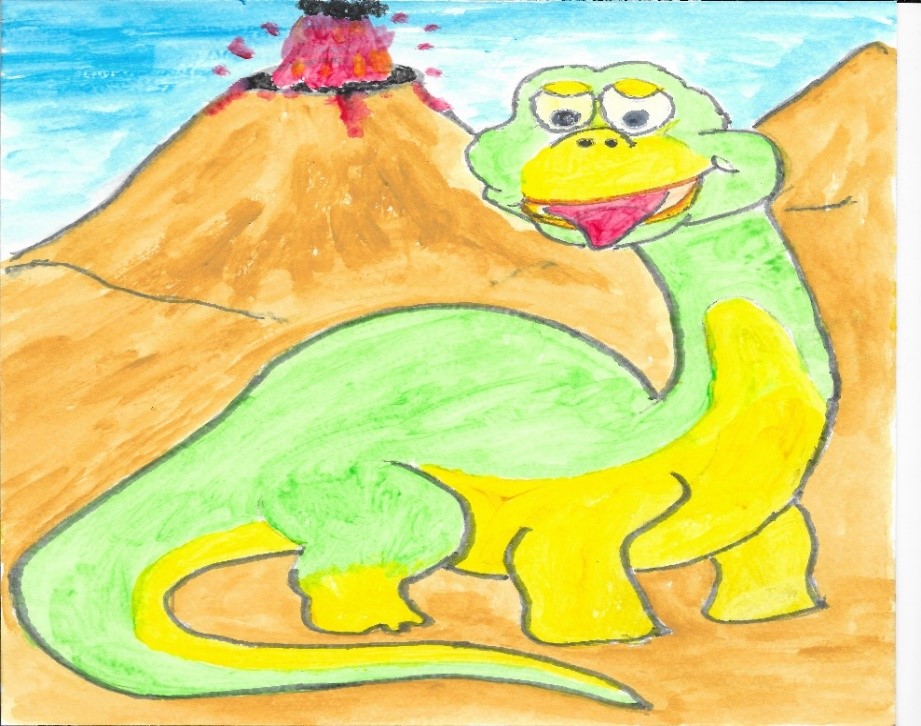
I am writing this ABC book for my grandson, Eric, to help him with his alphabet. As most of you know, he is dyslexic and borderline autistic. He gets very frustrated at his lack of ability to read as well as his cousin, Ellie, who is the same age. I’m always trying to think up ways to help him and make it interesting. If he can memorise the animal names, the rest will come as he masters his dyslexia more. It is coming, and I’m so proud of him. I've found many interesting facts about the animals I’ve featured, and hope all children will enjoy reading about them, and I hope you enjoy them too.
Dd is for Dinosaur
Dinosaurs were animals
that grew to such a size,
they had the largest bodies
but really weren’t that wise.
It’s said the veggie eaters
had brains the size of peas,
Meat eater’s brains were bigger--
(for some, that’s sure to please!)
Fun facts on Dinosaurs
The word dinosaur comes from the Greek language and means ‘terrible lizard’. The word was named by English fossil studier ( paleontologist - pa-lee-on-tologist) Richard Owen in 1842 and was meant to refer to the Dinosaurs' huge size rather than their scary looks.
Dinosaur vegetable eaters had a brain the size of a pea, whereas their meat eating cousins, had larger brains. This was because they needed better sight, hearing, and a sense of smell to catch other animals for their daily meals. Though larger, their brains were only about the size of an ostrich brain. To give you an idea of how big that is, an ostrich’s eyes are the same size as a snooker ball, and its brain is smaller than that.
To help the plant eaters protect themselves against the stronger meat eaters, many were gifted with some great natural weapons. Spikes on their tails and/or three horns on their head shields.
Dinosaurs lived on Earth for more than 180 million years and were some of the hugest, most powerful creatures ever to have lived. Although they were massive, they all came from eggs. It is said that some birds we see today have evolved from dinosaurs, and even had feathers way back then!
Some Native American tribes thought dinosaur skeletons belonged to the ‘fathers of buffaloes.’ That would be more understandable than what many Englishmen believed 300 years ago, that dinosaur bones came from elephants; that's okay, but some believed they were the bones of giant humans. That would have made them a lot taller than our houses!
| Author Notes | Thank you for reading letter D in the alphabet. The top dino, is my husband's drawing, :)) and the other two are from Pixabay. |
![]()
By Sandra Stoner-Mitchell
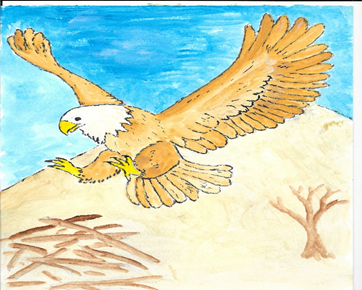
I am writing this ABC book for my grandson, Eric, to help him with his alphabet. As most of you know, he is dyslexic and borderline autistic. He gets very frustrated at his lack of ability to read as well as his cousin, Ellie, who is the same age. I’m always trying to think up ways to help him and make it interesting. If he can memorise the animal names, the rest will come as he masters his dyslexia more. It is coming, and I’m so proud of him. I've found many interesting facts about the animals I’ve featured, and hope all children will enjoy reading about them, and I hope you enjoy them too.
Ee is for Eagle
How majestic looks the Eagle
as he soars across the sky.
He can spot the smallest creature
on the ground from way up high.
How powerful his talons are,
while clamped around his prey
to take them to his mountain nest,
high up and far away.
Fun Facts of Eagles.
Eagles have very unusual eyes, with a million light-sensitive cells, they have five times more than humans. While we see three basic colours, red, green and blue, eagles see five. These differences give the eagle really good eyesight, and even the most well hidden prey are not safe from them. It is believed that an eagle can spot an animal the size of a rabbit up to two miles away.
Some eagles only have short wings, 17 - 21 inches, but have long tails, this allows them to hunt in forests. Whereas the largest eagles can have wingspans of between 72 - 96 inches, allowing them to soar high in the sky and over plains and water. While these eagles are big, the female is larger than the male because she must protect her eggs from preditors.
Eagles normally mate for life, and use the same nest all the time. They build the nest together, and when the female is sitting on the eggs, the male fetches her food.
The Bald Eagle is the national bird of America. While Benjamin Franklin wanted the wild turkey, the other founding fathers agreed the eagle would be a better symbol.
In Greece, golden eagles eat turtles. They will fly up high, carrying them in their strong claws, and then drop them onto the rocks to smash their very tough shells.
Eagles are at the top of the food-chain. While they hunt for their food, nothing hunts the eagle.
There is a legend that the Aztec people of Mexico found the perfect place to build a new city by searching for an eagle perched upon a cactus eating a snake. When the people found this eagle, it was on a swampy island in the middle of a lake. Although not the best place to build upon, the Aztecs weren’t about to argue with the prophecy, and set about building a mighty city, one that, centuries later, became the site of the Capital of Mexico. The picture of the eagle sitting on a cactus and eating the snake is the symbol on the Mexican flag.
| Author Notes | Thank you for reading my letter E. This is written in UK English. |
![]()
By Sandra Stoner-Mitchell
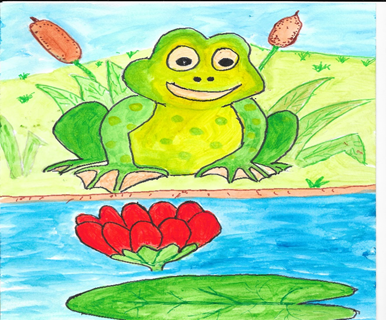
I am writing this ABC book for my grandson, Eric, to help him with his alphabet. As most of you know, he is dyslexic and borderline autistic. He gets very frustrated at his lack of ability to read as well as his cousin, Ellie, who is the same age. I’m always trying to think up ways to help him and make it interesting. If he can memorise the animal names, the rest will come as he masters his dyslexia more. It is coming, and I’m so proud of him. I've found many interesting facts about the animals I’ve featured, and hope all children will enjoy reading about them, and I hope you enjoy them too.
Ff is for Frog
The frog sits down so quietly--
his mind’s on just one thing:
he’s waiting for his lunch to come;
his tongue’s coiled like a spring.
Then, when a fly comes whizzing by,
the frog’s tongue zooms out fast;
the fly is stuck, the frog’s in luck--
his meal has come at last!
Fun Facts on Frogs
Frogs lay their eggs in water, and then they hatch into tadpoles. These live in water until they change into adult frogs. Tadpoles look more like baby fish than frogs as they have long finned tails and breathe through their gills, just like fish.
Once the tadpoles become frogs, they will live on the land, but their habitat must always be near water. This is because they will die if their skin dries out.
Frogs' tongues are amazing; they have so many uses.
First: They are very sticky and incredibly fast. They can snatch their prey in mid-air in under .07 seconds, five times faster than we can blink.
Second: Unlike us, their tongues are not attached to the back of their mouths, instead, they are attached to the front. This allows them to stick their tongues out farther so they can catch more flying insects.
Third: Another amazing thing a frog can do with its tongue is lift something four times its body weight. That would be like us humans lifting a motorbike or refrigerator with our tongue!
There are so many strange facts about frogs. For example, they use their eyes to help them swallow food! When they blink, their eyeballs are pushed downwards creating a bulge in the roof of their mouth. This bulge squeezes the food inside the frog’s mouth and pushes it down the back of its throat.
This is especially helpful for the ‘Pipidae’ tongueless frogs that are found in South America and Sub-Saharan Africa. These have webbed feet and claws on some of their toes. All that, but no tongue. Unlike the land frogs, these live in the water and hardly ever come out. They catch their food the way fish do, or they will shovel it in their mouths with their hands.
The few tadpoles that will survive from the four thousand plus eggs into adulthood, will live as frogs for between four and fifteen years.
One other useful tool that frogs have, is they can see forwards, sideways and upwards all at the same time.
| Author Notes | Thank you so much for reading my letter F. This is written in UK English. My husband (Graham) is the artist for the top picture, the second cartoon frog is from Pixabay because I couldn't find a picture of a frog catching a fly with his tongue. I think they are faster than the camera can click! The other pictures are from Pixabay as well. |
![]()
By Sandra Stoner-Mitchell
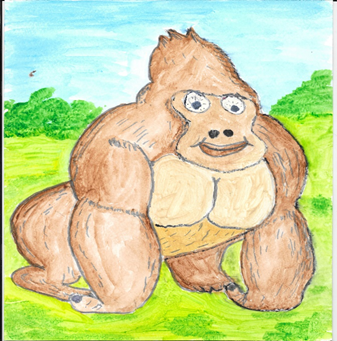
I am writing this ABC book for my grandson, Eric, to help him with his alphabet. As most of you know, he is dyslexic and borderline autistic. He gets very frustrated at his lack of ability to read as well as his cousin, Ellie, who is the same age. I’m always trying to think up ways to help him and make it interesting. If he can memorise the animal names, the rest will come as he masters his dyslexia more. It is coming, and I’m so proud of him. I've found many interesting facts about the animals I’ve featured, and hope all children will enjoy reading about them, and I hope you enjoy them too.
G is for Goril la
Gorillas are so big and strong,
and rather clever, too.
They each have personalities;
a lot like humans do.
They dine on fruit, and bamboo shoots;
and grubs, fat slugs and snails.
And then they groom each other with
their teeth and fingernails.
Fun Facts on Gorillas
Gorillas are quiet, gentle animals ... unless they are defending their family. These groups are called a troup or band. The leader is the oldest member in the troup. He is called a Silverback, so called because he has a line of silver hair down the middle of his back. He is also mighty strong, so be warned, it is not wise to tangle with one of them.
They are known to be one of the strongest and most intelligent animals in the world. In the wild they can live up to thirty-five years of age, but in captivity they have been known to live to the great old age of fifty.
They do have their own language, body and vocal, which they use to share information, and more so when they go courting. They also use language to teach their young children survival skills such as how to search for food. A gorilla in captivity is also capable of learning basic sign language, just as chimpanzees and orangutans can.
Baby gorillas sleep in their mother’s nest until they are 2½ years old.
The youngsters love to run around and play games together; chasing each other up trees and getting into all sorts of mischief, just like human children.
In 2005, gorillas in the wild were spotted making and using their own tools. One was also seen using a long stick to test how deep a swamp was before he walked through it.
All this is hardly surprising because Gorillas have at least 95% human DNA, and have their own unique fingerprints. They show emotion, such as grief, compassion, love and anger.
The sad fact is there are not so many left and are now a critically endangered species.
| Author Notes | Thank you so much for reading my letter G. This is written in UK English. My husband (Graham) is the artist for the top picture, the other pictures are from Pixabay. If you come across any errors, I'll be so grateful if you let me know. Thank you!! |
![]()
By Sandra Stoner-Mitchell
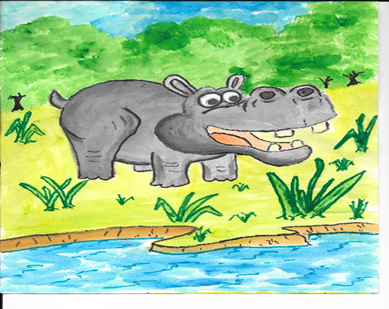
I am writing this ABC book for my grandson, Eric, to help him with his alphabet. As most of you know, he is dyslexic and borderline autistic. He gets very frustrated at his lack of ability to read as well as his cousin, Ellie, who is the same age. I’m always trying to think up ways to help him and make it interesting. If he can memorise the animal names, the rest will come as he masters his dyslexia more. It is coming, and I’m so proud of him I've found many interesting facts about the animals I’ve featured, and hope all children will enjoy reading about them, and I hope you enjoy them too.
H is for Hippopotamus
The Hippo bulls stand wide and tall,
and have such hefty heads!
with mega mouths and bodies that
they like to keep well fed.
I don’t know how they got so big,
when all they eat is grass.
But even though they weigh a lot
they can run super fast.
Fun Facts on Hippopotamuses
The name, hippopotamus, comes from the combined Greek words, Hippos, meaning horse, and Potamus, meaning water. They were named by Ancient Greeks who visited Africa and saw the large animals swimming. The male is called a bull, and the female, a cow.
Hippopotamuses spend up to fifteen hours a day in the water. They can hold their breath for five minutes under water before surfacing to breathe. They do this automatically, even while sleeping and not waking up.
Hippos can’t survive long out of water because their skin is very sensitive to the heat. While lying in the sun, a red oil, which has been named blood sweat, is released from their body to keep the skin moistened. It also acts as an antibiotic, which speeds up their recovery and wards off insect bites.
Hippos have huge appetites. The adults will eat about eighty pounds of grass and fruit every night, and will travel up to six miles to get their fill. If food is scarce, they can go up to three weeks living off the food they have stored in their tummies.
With female adults weighing up to three thousand pounds, and the males weighing up to a massive nine thousand pounds, they are not animals to mess with!
Mother hippos can only have one calf every two years. The babies weigh in at between fifty and one hundred and ten pounds! When it dives, the calf automatically closes its nose and ears, while a film covers the eyes for protection. Baby hippos become adults between the ages of five and seven years. They can live for about thirty-five years.
Hippos live together in groups of up to thirty, though some have been seen in much larger groups. The dominant male will choose his partner, leaving the other males to fight each other for the remaining females.
Sadly, Hippopotamuses are in decline in Africa and are classified as vulnerable due to man's unregulated hunting for their meat, skin, and the ivory in their teeth. They are already extinct in three African countries where man has taken over their habitats.
| Author Notes |
Thank you for reading my letter H. If you find any errors, please let me know, I'll be so grateful. :) I hope you enjoyed this one. Written in UK English.
The top picture was drawn by my husband, Graham, and the other lovely pictures are from Willm78 on Pixabay |
![]()
By Sandra Stoner-Mitchell
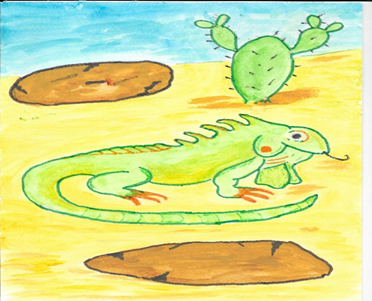
I am writing this ABC book for my grandson, Eric, to help him with his alphabet. As most of you know, he is dyslexic and borderline autistic. He gets very frustrated at his lack of ability to read as well as his cousin, Ellie, who is the same age. I’m always trying to think up ways to help him and make it interesting. If he can memorise the animal names, the rest will come as he masters his dyslexia more. It is coming, and I’m so proud of him. I've found many interesting facts about the animals I’ve featured, and hope all children will enjoy reading about them, and I hope you enjoy them too.
I is for Iguana,
Iguanas are quite friendly guys;
their tails are really long--
they use them to defend themselves
because they’re mega strong.
They swim and run and climb up trees;
that’s what iguanas do.
Their meals are mainly fruit and leaves,
and some small insects, too.
Fun Facts For Iguanas
Iguanas are cold-blooded creatures so they do like to sunbathe as much as possible. There are several kinds of iguanas both in size and colour.
Green iguanas are more commonly at home in the Tropical Rainforest living high up in the trees. Since they live mainly on leaves, they will never want for food. They have strong jaws and very sharp teeth. They use them to chomp through tough leaves, and, together with with their razor-sharp claws and tails, to attack predators with when they are threatened.
Marine iguanas from the Galápagos islands are skillful swimmers. They rub their sharp bodies along the rocks at the bottom of the sea to loosen the green and red algae for their meals. These iguanas can hold their breath for up to five minutes, although it has been recorded that one iguana stayed underwater for almost forty-five minutes before coming to the surface for air. They are black in colour which helps to keep them warm whilst swimming in the cold ocean.
Iguanas have a ‘third eye’ on the top of their heads. It’s a tiny white scale between the two other eyes. These can only see light and dark shadows. What is most useful about this little eye is it can detect motion; that’s all they need to warn them if an enemy is sneaking in from above.
The green iguana can fall forty to fifty feet and survive, which is handy if they fall out of trees. Iguanas also have lots of extra skin below their necks. This is called a dewlap and is there to help these cold-blooded creatures control their body temperature.
If caught up in a fight, iguanas can hold their own by thrashing their sharp, long tails around. Should the tail get broken off, it will give the iguana a chance to escape, but it will eventually grow back.
Although it doesn’t seem like it, iguanas are very sociable and can often be seen pair-bonding. They have a high level learning capacity, with the ability to solve problems. They also make excellent pets to people who know how to look after them. You should look up how to keep them before you do, as it is very complicated. After a while, the iguanas will recognize you, just like any other pet.
Iguanas are among the world's most endangered animals due to humans' harvesting for their own use, as well as taking away their habitats for development. Without the iguana, who are important seed spreaders, many native plants would die out. Their protection is vital for environmental health.
| Author Notes |
Thank you for reading my letter I. If you find any errors, please let me know, I'll be so grateful. :) I hope you enjoyed this one. Written in UK English.
The top picture was drawn by my husband, Graham, and the other lovely pictures are from Scottslm on Pixabay |
![]()
By Sandra Stoner-Mitchell
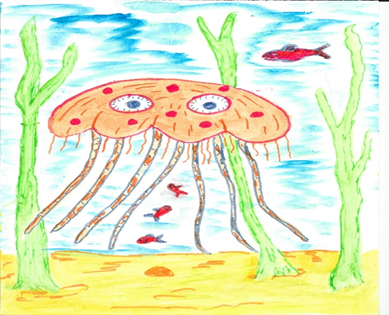
I am writing this ABC book for my grandson, Eric, to help him with his alphabet. As most of you know, he is dyslexic and borderline autistic. He gets very frustrated at his lack of ability to read as well as his cousin, Ellie, who is the same age. I’m always trying to think up ways to help him and make it interesting. If he can memorise the animal names, the rest will come as he masters his dyslexia more. It is coming, and I’m so proud of him. I've found many interesting facts about the animals I’ve featured, and hope all children will enjoy reading about them, and I hope you enjoy them too.
J - is for Jellyfish
There are so many jellyfish
of different shapes and size,
if I could show you all of them,
you’d not believe your eyes.
Some jellyfish have rows of teeth
but not a brain or heart,
and none of them have any bones--
You’d think they’d fall apart!
***
Fun Facts For Jellyfish
Even though their name suggests they are fish, they are actually animals without backbones. A group of jellyfish - which can consist of up to three hundred thousand - is called a “bloom,” a “swarm” or a “smack.”
***
The Immortal Jellyfish
Their scientific name is Turritopsis dohrnii
The Immortal Jellyfish were first discovered in 1883, but it wasn’t until the 1990s that scientists discovered their ability to live forever. When they are about to die, these amazing creatures can regress back to their ‘childhood’ and start again.
They can die, and do, when eaten by bigger fish, or sucked into the vent of a nuclear power plant. Also called Hitchhikers, the Immortals are known to hitch a ride on cargo ships that use underwater ballast. This means they have been able to populate all the world’s oceans. Being the size of your little fingernail makes these Immortal Jellyfish hard to spot, though.
***
Box Jellyfish
Their scientific name is Cubozoa.
Living mainly in Northern Australia and the Indo-Pacific, the Box Jellyfish are ones to stay clear of. Their sting is lethal, and unbelievably painful. Also called Sea Wasps and Stingers, they are more powerful and deadly than the killer shark.
Box Jellyfish have twenty-four eyes of four different types, most of which are like ours with lenses, corneas and irises. They also have one set that is used only for looking at the sky. Ordinary jellyfish can only detect light from dark.
***
Spaceship Jellyfish, commonly called Moon Jellies.
Their scientific name is Aurelia aurita
In 1991, almost two thousand jellyfish were sent into space to orbit Earth in a shuttle. This was part of an experiment NASA organised to see how the lack of gravity in outer space would affect them, and how adult jellyfish would react when brought back into Earth's gravity. Jellyfish are the same as humans where gravity is concerned.
While in space the jellyfish produced many baby jellies. By the time they were brought back, they discovered there had been more than sixty thousand jellies orbiting Earth.
The result of the scientist’s experiment was that the jellyfish born in space could not cope with our gravity. It is now thought that human babies born in space would have the same problem.
***
Lion’s Mane Jellyfish
The scientific name is Cyanea capillata.
The Lion’s Mane Jellyfish is the world’s largest of the jellyfish species. It can have tentacles that are over 27 meters (88 feet) long - longer than the size of the blue whale which is the biggest mammal in the world!
They live in cooler waters, particularly the Arctic, North Atlantic, and North Pacific oceans. They don’t usually come close to shore, preferring to stay way out in mid ocean. Like most jellyfish, apart from the immortals, their life-span is only about one year.
As well as being very long, the Lion's Mane tentacles has eight groups on its bell, and each group has anywhere from seventy to one hundred and fifty. That means a single jellyfish could have as many as one thousand, two hundred tentacles!
***
Lastly, but by no means least...
Beroid Comb Jellyfish
The Beroid Comb jellyfish has hundreds of rows of “teeth” made of tiny hairs that fuse together to pierce, tear and pull their prey into their stomachs. Described as sacks with large mouths, the only food these little lovelies eat are other Comb Jellyfish. Now, how neighbourly is that?
Unlike other Comb jellies, the Beroid doesn’t have tentacles. This is because of their huge mouths, they don’t need them to catch their prey. If a comb jelly is too big to swallow in one go, it can use their teeth to chomp big bites out of them.
To Summarize
While they don't possess brains, all jellyfish still have neurons that send all sorts of signals throughout their body. Instead of a single brain, jellyfish possess a net of nerves.
There are more than two thousand different types of jellyfish of which only about seventy can hurt people, with the box jellyfish being the most dangerous.
Scientists believe that there could be as many as three hundred thousand different species of jellyfish yet to be discovered, although I'm not sure how they came up with that number. As you might have guessed, Jellyfish are not in danger of becoming extinct!
***
| Author Notes | Thank you so much for reading about the Jellyfish. I researched all the facts through Google search. This is just the tip of the iceberg, there are so many more fascinating, and beautiful, jellyfish that do so much more than float around and sting you. It is worth looking them up. This is written in UK English. |
![]()
By Sandra Stoner-Mitchell
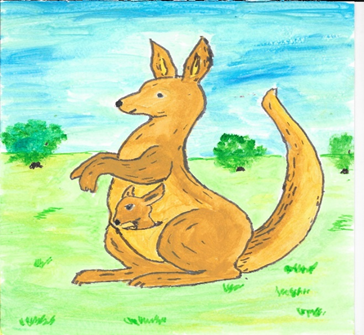
I am writing this ABC book for my grandson, Eric, to help him with his alphabet. As most of you know, he is dyslexic and borderline autistic. He gets very frustrated at his lack of ability to read as well as his cousin, Ellie, who is the same age. I’m always trying to think up ways to help him and make it interesting. If he can memorise the animal names, the rest will come as he masters his dyslexia more. It is coming, and I’m so proud of him. I've found many interesting facts about the animals I’ve featured, and hope all children will enjoy reading about them, and I hope you enjoy them too.
K is for Kangaroo
I’d like to see a Kangaroo,
I’ve heard they have big feet
and hop as fast as horses run,
and they can swim a treat.
I’d like to see those kangaroos--
the ones that live in trees,
and what about the wallaby?
There’s more kinds such as these.
Fun Facts on Kangaroos
Male kangaroos are called Jacks, Boomers or Bucks; females are called Jills, Does or Flyers. Male and female babies are called Joeys. The reason for this is the name, joey, originates from the Aborigine language meaning, ‘small animal’. Joey is the name they give for all small animals.
It must be very useful to be able to move your ears around without moving you head the way kangaroos can. No one would talk behind your back!
Kangaroos are ‘marsupial’ animals, meaning they have a pouch. They can be found in Australia and New Guinea.
***
RED KANGAROO
Red Kangaroos are the largest of all the kangaroos. They mostly live inland and can survive on very little water. Although they’re able to run at least as fast as thirty miles per hour, they can’t walk backwards.
The red kangaroo males, and some larger species of the wallaby males, continue to grow bigger and stronger throughout their life. Their lifespan can be eight years in the wild, and up to twenty-five years in human care.
The red kangaroo is not an endangered species.
WALLABY
The main difference between the kangaroo, wallaroo and the wallaby, is size. The wallaby is the smallest of the three species, with the wallaroo coming in at a size between the two.
There are other differences, too, if you can get them to open their mouths to look at their teeth.
The wallaby: which lives in forests, eats mostly leaves and has flat grinding back teeth with flat crowns and smaller front cutting teeth.
The kangaroo: which mostly eats grass, has a more noticeable front cutting set of teeth, with curved ridged crowns which are better for cutting and shearing the grass.
Although the wallaby is not endangered, there is a certain species called the ‘rock wallaby’ that are considered to be so.
TREE KANGAROO (my favourite)
The tree kangaroo was first discovered in the Torricelli Mountains of Papua New Guinea in 1990. It has a chestnut-brown coat, pale belly and double stripe down its back. More were later discovered on the Indonesian side of the New Guinea island in 2005. To watch them gracefully move in the trees, many have said it is just like watching the best of the Olympic gymnasts.
Several million years ago, all kangaroos were once tree dwellers. Then over a long period of time, they came down from the trees and began living on the land. Eventually, some went back into the trees and became the tree kangaroo dwellers you can see now.
Scientists say the numbers have been steadily falling due to the destruction of their habitat and from being hunted.
ANTILOPINE KANGAROO
The Antilopine kangaroos enjoy spending time in each other's company, although the older males often prefer to spend time on their own. They will either go in groups, or separately, when they search for grazing areas. Preferring the short shoots of grass, it can take them a few miles away, but they always return to the same camp.
As you might have guessed, their name comes from its fur being the same colour, feel and texture as the antelope.
The antilopine kangaroos are not in danger of becoming extinct.
***
And Finally
KALARI: ALBINO KANGAROO
Simon Watharow, editor of Australian Wildlife Secrets Magazine, told how he spent more than five years tracking an albino kangaroo. He named her Kalari, which means daughter.
He said his time watching her had shown him how groups of kangaroos would surround her to protect her from predators and curious humans. In fact, many people told how when they stopped their car to look at her, the others immediately went into protective mode and surrounded her many kangaroos deep.
***
A few little extra facts
The mother kangaroo can feed two different babies different types of milk at the same time. This happens when the older baby has just left the pouch and still needs feeding, as well as the newborn baby.
Kangaroos can only have one baby at a time. If another is started before the one in the pouch is ready to leave, she can delay the birth.
Newborn babies are the size of a jelly bean when they crawl into their mother’s pouch. They stay there for about six months until they are big enough to leave.
| Author Notes |
My thanks to:
https://www.worldwildlife.org/species/tree-kangaroo https://www.nationalgeographic.org/ https://kangaroocreekfarm.com/ Thank you again for all your support and help in this project of mine, I really appreciate you all. My thanks to Pixabay.com, for the lovely pictures, and to Graham, my hubby, for his illustration at the top. I look foreward to bringing the letter, L, to you next. Have a lovely week. xx |
![]()
By Sandra Stoner-Mitchell
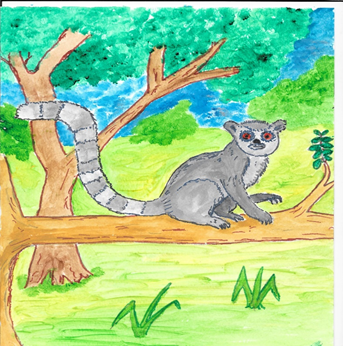
I am writing this ABC book for my grandson to help him with his alphabet. I've found many interesting facts about the animals I’ve featured, and hope children of all ages, 9-109, will enjoy reading about them.
L is for Lemur
They live wild in Madagascar
these Lemurs with long tails,
and make the strangest noises with
their snorts and clicks and wails.
And did you know Lemurs can sing?
And when they’re stroked they purr?
They eat bananas, figs and leaves,
then sit and brush their fur.
Fun fact for Lemurs
The Ring-Tailed Lemur's (lee mers) tail is longer than its body; it is used for balance as they climb and move through the trees. When on the ground searching for food, they also use their tails as a visual beacon for the rest of the group by sticking it up in the air.
The male ring-tailed lemurs have ‘stink fights’ when two go after the same female. They put nasty smells from their bottoms, wrists and shoulders, onto their tails and wave it around. The ‘stinkiest’ one wins! If a lemur’s smell isn’t very strong, the rest of the group considers it a sign of weakness. They also use the ‘stink’ method when they go courting. How nice!
***
The Aye-Aye Lemur is one you either love or hate. His middle finger is very long and spindly and sets him apart from other lemurs. The meaning of their name has had many people guessing. After reading a few of the explanations, I thought this one from Simons and Meyers, (2001) who said they believed it came from the Malagasy word, "heh heh", meaning, ‘I don't know’, was so funny, it had to be the truth.
These ruffed lemurs are the only primates that build nests in trees for their babies. Most carry their young around with them, but the ruffed lemurs leave them in their nests when they are out looking for fruit to eat.
***
The Indri Lemurs mate for life, and only have children once every two or three years. They are amazing jumpers, able to take long leaps of up to 10 meters when moving among tree branches. They are also rather good at leaping sideways. These lemurs don’t have much of a tail, but do have large hands.
They have a little button nose, small eyes, and very round ears. Many people think they look a lot like teddy bears!
The indri lemurs are able to sing; it’s both frightful and beautiful to listen to. Click on the link below to hear them. If you don't smile and cringe at the same time, I'd be most surprised. Their songs can be heard by humans over a mile away. Although they have been named 'indri lemurs', their name locally is babakoto, or ambalana. The misunderstanding about its name came about when local people pointed and called out, ‘indri, indri!’ which translated means, ‘There it is, there it is,' to the person who believed he had discovered it.
A few extra facts
The lemurs main tongue hides a small one behind it. This is a lot stiffer and is used to help keep their bottom teeth clean and hair free when they groom other lemurs. They can then move the bugs into their mouths for a tasty snack.
Lemurs can see perfectly well at night, but most still prefer their sense of smell to guide them.
As of now, there has been a 95% decrease of the ring-tailed lemurs, the most popular animals of Madagascar, since the year 2000. This is due to natives taking more and more of the tropical rain forest for farming, and they are also hunted for food. Unfortunately, there are now more of them in zoos and wild life parks around the world than remain free in the wild.
| Author Notes |
![]()
By Sandra Stoner-Mitchell
I’m so excited, I had to tell you all that the fourth book, Eric and the Mermen, has now come out on Amazon. To see Eric’s face was just so mind-blowing. I couldn’t be a happier grandma if I’d won the lottery. (no chance of that)
I want to thank you all for being there for me, and helping me in this project. One day he will be able to read the books by himself, I’m sure of that. He has such a strong desire to master this dyslexia that, with the school's help and his parents, I know he will do it.
These are the covers, I had Eric on each of them. His claim to fame!
Book 1: Eric and the Aliens. This is where it all began.
https://www.amazon.com/Eric-Aliens-Erics-Epic-Adventures/dp/1791762360/ref=sr_â??
Book 2: Eric and the Indians. What a hero! Eric rescues Ellie May from the Indians, who are really nice people.
https://www.amazon.com/Eric-Indians-Erics-Epic-Adventures/dp/1694974200/ref=sr_
Book 3: Eric and the Mummies. Here the duo meet Noah and Magot Mummy as they go deep into the tomb. Fun and games in this one!
https://www.amazon.com/Eric-Mummies-Erics-Epic-Adventures/dp/B0892DJTCG/ref=sr
Book 4: Eric and the Mermen. Eric and Herbie find Atlantis and a lot more. Mermen, Aliens spaceships and a new galaxy!.
https://www.amazon.com/Eric-Mermen-Erics-Epic-Adventures/dp/B089TXGPVC/ref=sr
These books were a labour of love, helped by you all to make sure they were perfect. Thank you all so much!
![]()
By Sandra Stoner-Mitchell
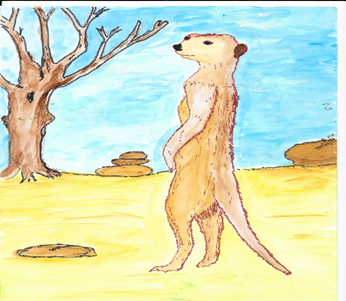
I am writing this ABC book for my 12 year-old grandson, Eric. I've found many interesting facts about the animals I’ve featured, and I hope children of all ages, 9 - 109 will enjoy them too.
M is for Meerkat
They live in burrows underground
with many rooms each side.
But when they need to go up top
their colour helps them hide.
When meerkats forage for their food,
there’s one who watches out;
and if a predator comes near,
he’ll give a warning shout.
Fun fact on Meerkats
Meerkats live in all parts of the Kalahari Desert in Botswana, in much of the Namib Desert in Namibia, south-western Angola, and in South Africa.
Even though they live in the baking hot desert, meerkats search for their food during the day. Their diet includes many yummy treats such as beetles, caterpillars, spiders, and a few nice scorpions. They also enjoy tasty things like small lizards, birds eggs, fruit and plants.
When hunting for food, one trusted member of the gang will stand on the highest point to keep guard. Having excellent eyesight, they can spot their enemies in the air from three hundred metres away.
Meerkats lead such dangerous lives. Because they enjoy a lovely mouth-watering scorpion for lunch, they have had to learn how to get rid of its poison. The scorpion may know danger is nearby, but the meerkat’s speed means it has no chance to attack or defend itself.
Once the meerkat has it firmly in its hands, the first thing it must do is bite off the scorpion's stinger tail. This leaves it with just its pincers, which can give an awfully painful nip, but that’s all. There is, however, still some poison on its shell. To get rid of this, our cunning meerkats have learned that rubbing the scorpion in the sand will remove any remaining trace of it. How cool is that!
Meerkat pups are taught at a very young age how to catch and kill a scorpion. From this picture it shows just how quick they are to learn.
While one group is out searching for food, some are left behind to babysit the new born pups. Their main job is to protect them from rival mobs of meerkats who will, given the chance, come and kill the babies. Well, I don't know about you, but I thought that was most unfriendly!
There aren’t many animals on Earth that work together as well as the meerkats. Groups are called clans, mobs or gangs, and belong to the mongoose family. These squirrel-size creatures can have gangs as large as fifty members. They live in burrows which they dig out with their long sharp claws.
Their black crescent shaped ears can be closed to stop any dirt getting in. They also have a tissue layer that covers their eyes and protects them while they are digging out their burrows.
In addition to their main living quarters, they will dig out bolt-holes all around their hunting area. These are places near enough for them to run and hide in during an emergency. Their biggest threats come from the eagles, jackals and some snakes.
.
Despite living in the desert, meerkats do not need extra water in their diets. They get all the moisture they need from the insects and grubs they eat. A human would die within 3 – 5 days without water ... unless you fancy a few nice grubs?
Meerkats are highly evolved creatures and possess some amazing talents. They can solve problems and tasks to rival chimps, baboons, dolphins and even humans. They do this by working together, but also using independent thought. A study at St Andrews University, in Scotland, saw meerkats engaged in a wide variety of behaviours to work out and finally complete tasks.
Meerkats can live up to eight years in the wild, but life can be harsh, and they have many predators. In captivity, they live between twelve – fourteen years and have been known to live up to twenty years. They are not on the endangered species list.
| Author Notes | Thank you so much for reading the letter M. If you should find any nits running around, please let me know so I can stamp on them. Thank you! :) |
![]()
By Sandra Stoner-Mitchell

I am writing this ABC book for my 12 year-old grandson, Eric. I've found many interesting facts about the animals I’ve featured, and I hope children of all ages, 9 - 109 will enjoy them too.
N is for Narwhal
Fun Facts on the Narwhal
The narwhals are also known as the ‘unicorns of the sea’ because of their long spiral tooth that grows out of their top lip. This can grow to lengths of between eight and ten feet long. It’s only the males that grow these long ivory tusks, although some females have been spotted with a very short one.
The narwhals normally travel in groups of between fifteen to twenty, but they have been seen in crowds of hundreds. Sometimes these larger groups get trapped by the moving ice, and then they are in danger of being killed and eaten by polar bears and walruses.
Narwhals change colour as they age. At birth, they are speckled blue-gray, teenagers are blue-black, adults are speckled gray, and the senior citizens are almost all white. Doesn't that remind you of us as we age?
Their tusks are a sensory organ and are filled with millions of nerve endings. Scientists wondered if they used it to communicate by rubbing it with another narwhal's, but since the female doesn't have one, they now think it's for showing off when they want to impress a girlfriend! I think that is more likely. How many other species like to show off? Think of the stag, the reindeer with their antlers, and human boys with their posh cars!
They have also been seen hitting fish to stun them before swallowing them whole.
Whilst researching these lovely creatures, I came across some questions put to Google. More than one person asked if the tusk, or long tooth, was used to spear their food. Really? How could they get the speared fish off the end of the tusk to be able to eat it? Hmm!
A Few Extra Facts
Unlike other whales that migrate, the narwhals spend their whole life in the Arctic. 75% of them live in the Canadian Arctic waters.
Narwhals can live up to fifty years, although their average age is between thirty and forty years.
In addition, I want to mention a bit of interesting information about another mammal to compare to the narwhal. The Arctic bowhead whale is the longest living mammal in the world. Some have been found with the tips of ivory spears still embedded in their flesh. This is from failed attempts to catch them by whalers, some two hundred plus years ago.
Narwhals have never been successfully kept in captivity – the only way you can get to see them is in the wild. The few places you can go include the floe edge of Lancaster Sound and the Baffin Bay in Canada’s High Arctic.
There are thousands of narwhals swimming in the ocean. But due to where they live, in the most remote and dangerous part of the world, there is still a lot we don’t know about them.
Up until the year 2020, narwhals were considered to be in the ‘nearly threatened’ category because there were only 50,000 around. But from recent studies this is no longer the case. There are now in excess of 175,000, lowering their status to ‘least concern’. This is good news. It's always nice to hear when a creature's status is improving.
| Author Notes |
Thank you so much for reading this letter N. All written in UK English. |
![]()
By Sandra Stoner-Mitchell
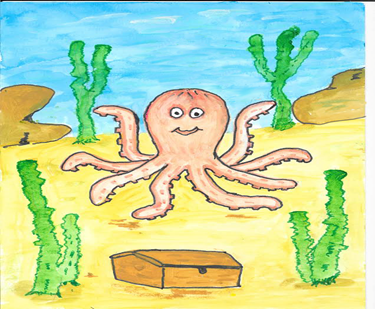
I am writing this ABC book for my 12 year-old grandson, Eric. I've found many interesting facts about the animals I’ve featured, and I hope children of all ages, 9 - 109 will enjoy them too.
O - is for Octopus
Each octopus has eight long limbs
and blood that’s coloured blue.
They have three hearts, but don’t have bones,
they’re very clever, too.
They have hard beaks; their tongues have teeth,
they’re masters of disguise.
If arms drop off, they’ll grow again,
Well, that was a surprise!
Fun Facts About the Octopus
Of the eight limbs an octopus has, two are legs that push them off the seafloor, the rest are arms. If an octopus loses a limb, it will grow back, but it takes a year or two.
At one time, it was thought only the blue-ringed octopus in Australia had a deadly venom. One bite from this lovely creature can kill an adult human in just minutes! Now though, it seems that most octopus, cuttlefish and some squid are venomous and can, in some cases, kill, if the victim is not treated quickly.
(Poisons will work their deadly deed if you touch them, inhale the poisonous fumes, or eat them; while venoms are injected straight into your body when an octopus bites or stings you.)
There are around 300 different types of octopus, and they're at home in every salt-water ocean in the world. Some live in the shallow water, and some live down as far as 6,600 feet. (Over a mile down!) You would most likely see some around the coralreefs as well as on the ocean floor. They don't like the toxins which are filling our seas and oceans these days.
Octopuses have very sharp beaks which you’ll find in the centre underneath the bulk of their body. This is used for many things, but mainly for drilling into the shells of prey. Their favourite, number one food, is the crab. Once they have drilled inside the hard shell, they use their salivary (spit) gland to both paralyze the crab and allow enzymes to get to work and dissolve the food.
Inside an octopus’s beak is a radial, a sort of tongue-like organ. The yellow ridges in the sketch below show you the blades covering the ‘tongue’ that pass for teeth and are very sharp.
The octopus is the master of disguise, and can even change its colour. When it’s frightened, it will turn white, and red when it’s angry. It also changes colour to hide, and can bend and twist its body into many shapes in order to blend in with the rocks and plants around them. Predators, like sharks, eels, and dolphins, swim by and don’t notice the octopus is there.
Pic 1 - octopus looks like a rock. Pic 2 - octopus looks like a conche.
If an octopus is discovered, it will spurt out a jet of mauve ink to cloud the attacker's view. It also dulls the predator's sense of smell, giving the escaping octopus an even bigger chance to get away.
Not being a creature that likes to hang around in the same place for long, the octopus will change homes every two weeks or so, although they rarely leave the area. They enjoy decorating their homes with whatever shells and weeds they can find. The smaller ones will find the most obscure places to live in, even bottles that humans have kindly thrown into the sea. Not having bones, octopuses can squeeze through the narrowest gaps, and fold themselves into the smallest crevices.
A Few Extra Facts
An octopus can reach speeds as high as 40 kilometers (or 25 miles) per hour.
Octopuses don’t live long, but scientists have told us that if they did, they would most likely be the most intelligent species on earth.
The females release more than 100,000 eggs after mating, but sadly only a handful reach adulthood. This is most likely because they are born near the surface and become easy prey for predators like large birds and other larger fish.
Octopuses are very adaptable and survive in very cold water as well as warm. What scientists have found interesting is that octopuses in the cold water are larger than those that live in the warmer oceans.
Some people have tried to keep them as pets in aquariums but have found out that it doesn’t work for very long. They are amazing escape artists, and can take the lids off their tanks and escape. They are so good at this, that even when it has been especially made, the octopus will still find a way to get out.
It is not advisable or nice to keep octopuses in captivity, they don’t live long when taken from their natural habitat.
Octopuses are not normally aggressive, and would rather hide than face a predator. Because of this, scientists were surprised to witness the female strangling her mate, then dragging his body into her home and most likely eating it! Perhaps it was something he said?
Octopuses are not an endangered species.
| Author Notes |
Thank you so much for reading my letter O. If you see anything that might not be right, including spelling, I'd be grateful if you tell me. (this is UK english) |
![]()
By Sandra Stoner-Mitchell
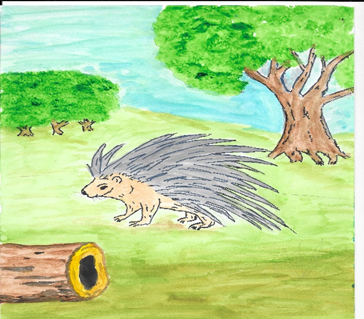
I am writing this ABC book for my 12 year-old grandson, Eric. I've found many interesting facts about the animals I’ve featured, and I hope children of all ages, 9 - 109 will enjoy them too.
P- is for Porcupine
The porcupines live in the trees,
their favourite food is wood.
Although their vision is quite poor
Their sense of smell is good.
With quills and claws insanely long
and teeth as sharp as knives;
their enemies should all beware
before they risk their lives .
Fun Facts about the Porcupine
Porcupines have about thirty thousand quills, and although it’s a myth that they shoot them at their predators, they are loose and come away easily. These quills are hairs with barbed tips on the ends. The only part of a porcupine’s body that doesn’t have them is on its stomach. The longest quills are on its bottom, and the shortest are on its cheeks.
The porcupine isn’t an aggressive creature, but will attack if it feels threatened. Most predators will happily give porcupines a wide berth, leaving them to walk along quite unhindered and fearless of almost anything. Although, it seems the young in animals don’t always listen to the warnings, as the cubs below discovered. At least one went home with a sore nose.
The razor edged quills easily come away when contact is made and each barb is pulled further into the flesh when the victim moves and tries to get it out.
Pic 1: full body of quills Pic 2: Single quill magnified to show barbs
*****
Many dogs have ignored the warnings that the porcupines send out and tried their luck. Most fail. Should your dog decide to have a go at one and end up with quills on its body, it is advisable that they be taken directly to the vet.
*****
Porcupines are split into two types, the old world and the new world. New World porcupines, which include the North American and Canadian porcupine, spend most of their time in trees. They are amazing tree-climbers, and since they feast on the bark, it’s an obvious place to live. They don’t hibernate during the winter, although many make their dens in caves or in hollow trees and remain there during the really bad weather.
Prehensile-tailed porcupines are one of the twelve species of New World porcupines that live in Central and South America. Their tails are bare, which they use for hanging and swinging just like monkeys do. They have bulging noses and are of a prehistoric, or even, alien appearance. They eat leaves, flowers, shoots, roots and the sapwood layer found beneath the bark of some trees.
These will not hesitate to attack a predator. They will stamp their hind feet when excited and curl up to protect their soft underbelly. They can produce a variety of sounds, from moans and whines to grunts, coughs, shrieks, barks and wails.
*****
Porcupines mate in late summer and early fall. Porcupines are very vocal during mating season. Males often fight over females and will perform an elaborate dance. Seven months after mating, the female gives birth to a single baby. When the baby is born, its quills are soft. (Nature can be so kind to mothers!) They harden about an hour after birth. The baby begins foraging for food after only a couple of days. The baby will stay with its mother for about six months.
*****
To Sum Up
Porcupines can be active night or day and are very selective in what they eat; wood, bark, leaves, shoots, buds, fruits and nuts. Although they appear awkward, apart from the Old World porcupines, the others of North and South America are actually tree-living, and forage, eat and sleep in the trees.
Also, another little known fact, porcupines swim! Their hollow quills keep them afloat.
| Author Notes | Thank you again for reading my ABC book. This is written in UK English. Any nits, (apart from any on the animals!) Please let me know. Thank you. |
![]()
By Sandra Stoner-Mitchell
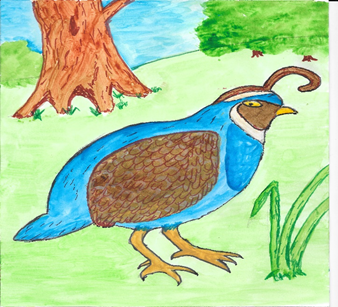
I am writing this ABC book for my 12 year-old grandson, Eric. I've found many interesting facts about the animals I’ve featured, and I hope children of all ages, 9 - 109 will enjoy them too.
Q is for Quail
Most quails are very sociable
with nests upon the ground.
They have a plume atop their head
that bobs as they walk round.
They sometimes make a high-pitched squeal,
but screech and grunt to talk;
and though they can fly fast and high,
they much prefer to walk.
Fun Facts on Quails
Old World v New World Quails.
The members of the old-world quail group are very small and live on seeds. Because they also eat insects and tiny animals, this makes them omnivores, creatures that eat a wide variety of food. They nest on the ground in long grass.
Old-world quail, such as the Japanese and the common quail, are regularly hunted by humans, especially the Japanese quail, for their meat and eggs.
The old-world common quail tend to eat poisonous seeds with no harm to themselves. The poison is then stored in their body fat, which has been proven to lead to the poisoning of people, and other animals, who later come to eat these birds. It can be fatal, or could lead to severe health problems.
Pic 1 Common quail Pic 2 Japanese quail
Although most quail prefer to live and walk on land, the old-world migrating quail can fly for very long distances. They have long, powerful wings, giving them the ability to fly the migratory journey between northern Europe and the Sahel belt in sub-Saharan Africa. The quail following the eastern route must cross the Mediterranean Sea.
New world quail
New world quail are very sociable birds, and gather in small flocks. They are easy-going birds and prefer to walk rather than fly. They can, however, be spurred into upward flight at a speed of up to forty miles per hour when frightened, or startled. They can only sustain this for a short time though.
Extra facts.
When quails find their ideal partner and mate, it is not just for one season, they do so for life. Both the male and female will take on the parenting duties, selecting the site for the nest. They share the duty of sitting on their eggs, and both are involved in the teaching their young how to be a quail. A real family life!
The name for a group of quail is a flock, covey, or bevy.
Quail have tiny brains. Among the quail, ostrich and emu, the birds that win the trophy for the dubious title of ‘bird dunces’ are the new-world quail.
Quail have many predators, mainly due to its small size. Snakes, owls, foxes, squirrels, dogs, cats, and man are just a few.
Quails in ancient Egypt.
With all the workers the Egyptians had to feed on the building sites, if you weren’t employed as a pyramid technician, you would most likely be farming wheat, fruit or raising quail. The Egyptians soon found out that quail was the best source of protein for their workers, and many large farms were now used for breeding them.
The quail became so common in Egypt it was given its own hieroglyph. You can see below that the quail is used for the U and W. To spell ‘moon’ would be: Owl = M, Quail chick = U (pronounced oo) Water = N
(if you put your curser in the bottom right-hand corner, you should find it will produce a larger picture.)
Quail feature in the histories of many countries through the ages. In the Far East the records show quail going back as far as 770BC. Quail have been bred domestically for over 4000 years for food as well as pets.
Just like the chicken has been added to the English language, meaning ‘to be scared or a coward’, the word quail has also been added to mean ‘to shrink back in fear, or cower’. Why it was portrayed as such, no one really knows. It really doesn't apply to quails when frightened because they will just fly straight up in the air.
Although many countries have laws setting a limit to the amount of quail that can be caught, unfortunately, they are not properly enforced. Due to the massive amount of hunting that goes on, there is a deep concern that these little birds will become extinct.
| Author Notes |
Thank you once again for reading my alphabet animals. 9 more to go! If you should find any errors, I'm always happy to have them pointed out. :) My thanks to my husband for the top picture and to Pixabay for the others. xx |
![]()
By Sandra Stoner-Mitchell
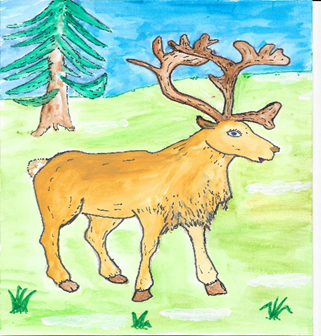
I’m writing this ABC book for my 12 year-old grandson, Eric. I’ve found many interesting facts about the animals I’ve featured, and I hope children of all ages, 9 -109 will enjoy them, too.
R is for Reindeer
The Reindeer live in Arctic parts
where it’s so very cold.
For keeping warm they have two coats,
which saves the heat they hold.
To find the moss, the food they love,
on journeys as they go,
they’ll use their sense of smell which can
detect it under snow.
Fun Facts on Reindeer
In North America reindeer are also called caribou.
Both the male and female reindeer grow antlers. In September, the males lock their large, hard and very strong antlers to fight for the right to mate with the females. They lose their antlers, one at a time, throughout October.
The females keep their antlers until the spring when the baby is born. They are used to defend their food territories from other females, which is vital whilst they are pregnant through the winter.
Reindeer Antlers
Reindeer are the only mammals that grow new sets of antlers every year. They are bony limbs that grow very fast, just under an inch a day, and are covered in a furry skin called velvet. This is made up of rich blood vessels that provide the oxygen needed for the growing bone. If you touch them, you will find they feel warm. The velvet skin later falls off to leave the bare, strong, sharp bone.
Pic 1 antlers covered in velvet skin. Pic 2 velvet coming off bone.
Like human fingerprints, no two antlers are the same. Each has its own shape and design. You seldom find antlers scattered around after the reindeer have shed them because they are eaten by other animals. They contain a wonderful source of calcium and minerals. Perhaps they'd make a nice tasty soup?
Reindeer Eyesight
It is thought that the Arctic reindeer are the only mammals able to see ultraviolet light, which is invisible to humans. The main advantage of this is the reindeer can see predators in the snow. They also have a reflective tissue in the eye. This changes the golden colour of their eyes during the summer months, to a deep blue in the winter.
While all this is interesting, these amazing eye features are only good if the weather is clear because fog tends to block the colour blue. But red can pass through. Remember Rudolf, the famous red nosed reindeer? Some reindeer actually do have red noses, specially designed with tightly packed blood vessels near the surface of the skin to warm the air before it gets into their lungs. It also keeps their nose warm each time they forage in the snow for their next meal. Just how closely packed the vessels are is revealed by how bright the nose is.
Now scientists are looking at Rudolf and his glowing red nose guiding Santa through the fog on Christmas Eve. They now think there might be something in the 'red nose glowing', theory, but so far it hasn't been proved.
Coping With the Cold
Reindeer are well prepared for the cold climate with fur covering their entire bodies including their hooves. Their fur is made up of two coats: a woolly undercoat, and an overcoat made of hollow air-filled hairs.
Another interesting fact about their amazing hooves is, they expand in the summer when the ground is soft, and become sponge-like to help give traction. In the winter, the pads shrink and tighten, exposing the rim of the hoof, they are then ready to help cut through the hard snow and ice. That isn’t all, their hooves can spread out and be used for snowshoes and spades in the winter to deal with all the snow, and later, they’re used like flippers for swimming! The picture below is of one hoof.
Those, and the hollow air-filled hairs in their coats make them especially buoyant; it’s a bit like having your own built-in life jacket! They are such strong swimmers, they can swim across rough, wide rivers and ice expanses of ocean for up to six miles per hour. Now we can see how an entire body of a reindeer was found inside a Greenland shark! Yes, that really did happen!
How fast can you run?
A newborn reindeer is up and moving around within an hour. A day old reindeer can outrun an Olympic sprinter! Adults can run at speeds of forty to fifty miles per hour. This is one reason that a reindeer is not on a polar bear’s dinner menu; their body would overheat while chasing one.
A Few Extra Fun Facts.
A reindeer can jump as high as 8ft, so you’ll need a 9ft fence to keep them out -- or in, and that is ginormous!
Unlike other members of the deer family, reindeer are not called bucks, does and fawns, but like cattle they are called bulls, cows, and calves. Reindeer are herbivores, animals that live on plants.
A reindeer is a four-legged mammal, having four hoofed toes. They are also ruminants. This means they have stomachs with four chambers, and are genetic cousins of cows and sheep. However, they are members of the cervidae family, meaning they have solid antlers. Their closest relation is the deer, but within the deer family, reindeer are unique.
Reindeer make a strange clicking sound when they walk. It doesn’t come from the hooves but instead from the tendons slipping over the bones in their feet. The purpose is to keep the herd together. Sounds are important when they can’t see clearly in foggy weather.
Climate Change
Reindeer eat lichen, and in the winter they must break through the hard packed snow and ice to get to their food. With the warmer weather, our oceans are also warming bringing on the rain which is dramatically changing the climate in the Arctic.
Back in November 2013 an unusual amount of rain fell non-stop over a twenty-four hour period. That night the temperatures plunged, leaving a layer of ice so thick it made it impossible for the reindeer to break and get to their food.
Because of that, sixty-one thousand reindeer died of starvation on the Yamal Peninsula in Serbia. Prior to that in November 2006, twenty thousand had died of starvation for much the same reason. A study has linked these events with climate change. No one wants to see this happen again. Biologists, scientists, and conservationists are working hard to study these effects so animals can have a better, and safer, existence. Their habitats are being threatened, but work is being done to prevent it from continuing.
| Author Notes | Thank you for reading my letter R, if you do find any errors, please let me know, I'm always very grateful. This is in UK English. Pictures my Pixabay and Unsplash, and of course the very top one is by Graham. (My hubby) |
![]()
By Sandra Stoner-Mitchell
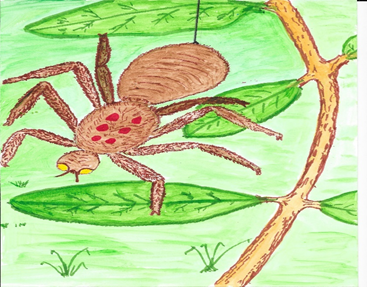
I’m writing this ABC book for my 12 year-old grandson, Eric. I’ve found many interesting facts about the animals I’ve featured, and I hope children of all ages, 9 -109 will enjoy them, too.
S is for Spider
A spider’s web of sticky silk
will capture bugs and flies.
They see whenever prey is near
because they have eight eyes.
A spider can adapt on land,
above and underground;
Antarctica’s the only place
a spider can’t be found.
Fun Facts on Spiders
Spiders are probably the most adaptable species on our planet. They can live almost anywhere in the world, except in Antarctica.
Many people think spiders are insects but they aren't. Spiders belong to the animal group, 'arachnids,' along with scorpions, mites and ticks. They have two main body parts and eight legs. Unlike the spider, the ant and the fly are examples of insects. Each of these has three main body parts, but the fly also has wings.
Spider Ant Fly
*****
Burrowing spiders aren’t the first creatures that come to mind when you think of what is living beneath the earth, the Wolf spider and the Trapdoor spiders are just two of the many that spend most of their time underground.
The Wolf Spider carries all of her hundreds of babies on her back until they are ready to leave.
The Trapdoor Spider is thought to have travelled from Africa to Australia millions of years ago. This wouldn’t have been hard when you realise that the continents were joined way back then, but it would have been a very long walk! The name Trapdoor spider comes from the distinctive trapdoor entranceway they make for their homes.
Wolf Spider Trapdoor Spider
*****
The Daddy long-legs have very toxic venom, but don’t worry, it’s only dangerous to insects. It could kill a human if their fangs were longer and strong enough to penetrate our skin. But, thankfully, they can’t!
*****
The Peacock Spiders are so named because of their similarity to the male peacock bird. They have shimmering, colourful scales on their bottom which they use to attract female spiders. This species is so small that the largest ones are only as big as the rubber the end of a pencil. If these pretty little spiders can’t catch the eyes of a lady with their lovely little rainbows, they have a plan B--they dance!
*****
According to a huge myth that has been around for centuries, the tarantula is a gigantic spider that kills humans with one bite. But this is not true.
A long time ago, the local people believed they were bitten by the tarantula, but in fact, it was probably the wolf spider instead. The real tarantula is nothing like this. It is more likely to run and hide when it feels threatened.
Most spiders can sense the heat from our bodies and will try their best to avoid us. The tarantula seldom inject venom, and if they do, it is no more harmful than a bee sting. There are about eight hundred known tarantula species.
The picture below of the Red Knee tarantula is very docile.
*****
King Baboon Tarantula is one of Africa's largest spiders. It has a leg span of up to 8 inches and has a rusty red-brown colour. These will feed on anything they can kill, but are totally harmless to humans. Their bite might be painful, but that’s all. Most spiders live for about a year. However, some tarantulas live more than 20 years.
*****
The Diving Bell Spiders. They construct an underwater bell in which they live. The spider swims to the surface to collect air and fills its diving bell. Bubbles then form on the hairs on the spider’s legs and body, allowing it to fill the bell and enabling it to swim outside the bubble for short periods of time.
*****
The Happy Spider. There are spiders in Hawaii that look like they are smiling, called the ‘Hawaiian happy-face spider.’ Unfortunately, these cheerful looking spiders are under threat of extinction. Most spiders don't take care of their babies; less than 1% of all spiders look after their young. However, the Hawaiian happy face spider is part of that 1% who shows motherly love. She guards her eggs and brings food for her babies to eat when they are small.
*****
A few extra fun facts.
There are approximately 38,000 known species of spiders. Scientists believe there are probably many more to be discovered.
An estimated one million spiders live on one acre of land. The number might be closer to three million in the tropics. It is estimated that a human is never more than ten feet away from a spider—ever.
Spiders are vital to a healthy ecosystem. They eat harmful insects, pollinate plants, and recycle dead animals and vegetation back into the earth. They are also a valuable food source for many small mammals, birds, and fish.
Spiders eat more insects than birds and bats combined. All spiders spin silk, but not all spiders spin webs.
Web-weaving spiders have two or three claws at the tip of each leg that they use to swing from strand to strand without getting stuck in the sticky part of their web. Additionally, a spider’s body has a special oily substance that keeps it from getting stuck in its web.
A spider’s muscles pull its legs inward, but cannot extend its legs out again. Instead, it must pump a watery liquid into its legs to push them out. A dead spider’s legs are curled up because there is no fluid to extend the legs again.
The Goliath is the world’s biggest spider. It can grow up to eleven inches wide, and its fangs are up to one inch long. It hunts frogs, lizards, mice, and even small snakes and young birds.
The Patu Marplesi is the world’s smallest spider. It is so small that 10 of them could fit on the end of a pencil.
The silk that comes out of the spider’s spinneret is liquid, but it hardens as soon as it comes in contact with air. Some spiders have up to seven types of silk glands, each creating a different type of silk—such as smooth, sticky, dry, or stretchy.
The Darwin Bark spider creates the strongest material made by a living organism. Their giant webs can span rivers, streams, and even lakes and are ten times stronger than Kevlar. (Kevlar is five times stronger than steel on an equal weight basis and provides reliable performance and solid strength).
A web made of strands of spider silk as thick as a pencil could stop a Boeing 747 jumbo jet in flight. Scientists still cannot replicate the strength and elasticity of a spider’s silk.
Hummingbirds use small sticks and the silk from spider webs to weave a nest for themselves.
Some male spiders give dead flies to the females as presents. Aww, that is so sweet!
Two kinds of jumping spiders have been found at 23,000 feet. At this height, no plants grow, but plant material blows up from lower elevations, which is enough to feed the tiny creatures.
Hundreds of years ago, people put spider webs on their wounds because they believed it would help stop the bleeding. Scientists now know that the silk contains vitamin K, which helps reduce bleeding. Now scientists in the United States Defense Department are trying to copy gold orb weaver silk in order to use it for bulletproof vests.
| Author Notes |
There is so much more I could have written about the creepy crawling spider, I know I'll have nightmares tonight, but perhaps this will help others. I hope you watch the film I've added, there are some incredibly beautiful spiders in the world. This is written in UK English. If you spot any errors, I'll be so happy if you let me know. Thank you for reading! xx |
![]()
By Sandra Stoner-Mitchell
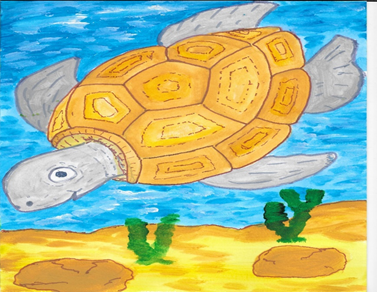
I’m writing this ABC book for my 12 year-old grandson, Eric. I’ve found many interesting facts about the animals I’ve featured, and I hope children of all ages, 9 -109 will enjoy them, too.
T is for Turtle
Turtle, Tortoise and Terrapin are all names for the hard-shelled, egg-laying reptiles. But, they are all turtles.
Sea Turtle Tortoise Terrapin
Turtles - Marine, ocean-going creatures.
Sea Turtles spend most of their life in the ocean, only leaving to lay their eggs in the sand. They have limbs that look like flippers with webbed feet. Although this helps them swim, it does make it a lot harder for them to move over the sand when they come to lay their eggs.
Sea turtles are very slow growing, and this most likely accounts for their long life. Although it’s hard to know how long they can live, some think it’s around fifty to eighty years for adults weighing between 240lbs and 420lbs. For the giant leatherback turtles, it is thought it could be well over one hundred years, with the largest of these coming in at a massive 2,000 pounds! It’s easy to recognise the leatherbacks from other turtles because they don’t have the hard shell.
Many turtle species are illegally hunted throughout the world for their meat and eggs, and for other products including oil, leather and their shells. This has meant many are considered critically endangered.
Giant Leatherback turtles
*****
Tortoises - Land dwellers
Tortoises are turtles that are slow-moving land reptiles who like to live in warm climates. They have hard, scaly, domed shells into which they can draw in their heads. This is especially handy for protection against predators. They have thick, chunky legs, and round, stumpy feet with claws for gripping and walking on land. Tortoises from hot countries have a lighter coloured shell than those from cooler climates.
Because tortoises don’t swim, they will burrow in the sand or earth to reach the cooler soil, or sand, in which to lay.
When the amazing Galapagos tortoises were first discovered by Bishop Thomás de Berlanga, four hundred years ago, there were 300,000 giant tortoises living happily on this island, which was given the old Spanish name Galapago, meaning tortoise. Then man came, and tens of thousands were slaughtered to be eaten by pirates and sailors; their shells were kept as trophies. Added to that, the habitats of these giant tortoises were, over the years, destroyed by the introduction of goats, pigs and rats. In the 1950s the Galapagos Islands were declared to be a national park.
Lonesome George
The most famous tortoise in the world was Lonesome George, the last of the La Pinta giant Galapagos tortoise subspecies, who died in June 2012 at one hundred years old. He was the poster boy for conservation throughout his life, and his death represented the extinction of these once-great creatures.
*****
Terrapin - Land and water dwellers.
Terrapins are turtles that spend time both on land and in water. The wild terrapins enjoy brackish, swampy water, while others like the freshwater ponds and lakes. They both like to climb out of the water to lay on logs and rocks to sunbathe. The word ‘terrapin’ comes from an Algonquian Indian word meaning ‘a little turtle.’
The wild swampy water terrapins on the left, and the freshwater terrapins are on the right.
Terrapins are very aggressive and will bite. They also ‘bark’ when something upsets them and makes them angry. The terrapins in New Zealand are usually infected with salmonella bacteria. This can be passed on to humans if they come into contact with them.
The male red-eared terrapins have very long claws on their forefeet and longer, thicker tails than the females. It is almost impossible to tell the gender of a terrapin until it is about eighteen to twenty-four months old. Females may breed at three to four years of age, but this timing seems to be related more to size than to age.
Some extra fun facts of the three Ts
The names terrapin, turtle, and tortoise can cause confusion. Turtles are sea chelonians, tortoises are land chelonians, and terrapins are freshwater and swampy water chelonians that spend some time on land.
Turtles can hold their breath for five hours. Tortoises can also hold their breath for a long time, but they need to empty their lungs before bringing their head back inside their shell. Terrapins can hold their breath up to thirty minutes.
Turtles love to eat jellyfish. They have special spikes in their mouth to hold them so they don't get away. Because their head doesn't slip into their shell like other turtles, they are more vulnerable to predators.
In most species, gender is determined during fertilization. However, the sex of most turtles, alligators, and crocodiles is determined after fertilization.
The sex of a turtle hatchling is determined by the temperature of the sand where its nest is. Research has shown that the hatchlings will be male if the temperature is below 81.86 Fahrenheit. If it is over 87.8, they will be female. When temperatures fluctuate between the two, there will be the perfect mix of males and females.
Unfortunately, as the Earth is experiencing climate change, the warmer sand means more females are born. Therefore, the species will not have a chance to continue because there will not be enough to mate and produce offspring.
Hopefully, conditions will improve as scientists make more observations and discoveries. Then, they can plan for the future of this species, along with many more facing difficult circumstances.
| Author Notes | Thank you so much for reading the letter T. I really appreciate you all. If you find any nits, I'm always happy to be told. This UK English. |
![]()
By Sandra Stoner-Mitchell
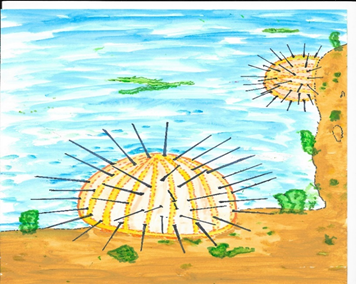
I’m writing this ABC book for my 12 year-old grandson, Eric. I’ve found many interesting facts about the animals I’ve featured, and I hope children of all ages, 9 -109 will enjoy them, too.
U is for Urchin.
Sea urchins are small animals
that don’t have brains or eyes.
They can still sense when danger’s near,
regardless of their size.
All urchins will eat anything,
there’s not much they won’t try,
they’ll eat both plant and animal.
whatever they come by.
Fun facts on Urchins
Although sea urchins don’t have a skeleton, they do have a hard outer body which is called a ‘test’. It’s made of ten plates joined together,
wrapped around the sea urchins, then covered in spines.
Urchins are mostly spiny, ball-shaped animals that were given their name because up until the 1500s, hedgehogs were called urchins. Some of the spiny sea urchins look just like them.
Hedgehog Sea hedgehog
Images from Pixabay
*****
Even though urchins don’t have brains or eyes, they can ‘see’ with their tentacle-like tube feet. Scientists believe they have light sensors that not only detect light, but sense nearby predators, or anything that might harm them. These sensors are all over their bodies and along their spines.
In a new study, researchers from Lund University in Sweden have since tested their vision. They discovered that even though they have low sensory vision, for an animal with no eyes, it is good enough to meet their basic needs.
In order to move, the urchins will use their hundreds of sticky tube feet to crawl over rocks and sand. The water moving in and out of their bodies helps them control the movement of their feet. Their spines also help them walk by using a layer of muscle under the test, their hard outer body.
Image by Jerry Kirkhart via Wikimedia Commons
Their beak-like mouth, called ‘Aristotle’s Lantern,' has five sharp teeth that can drill through rock. This is on the underside of their bodies, which is handy for scraping their food off the rocks and other surfaces as they move along.
*****
In recent years, the soaring growth of the gluttonous purple sea urchin has devastated the huge forests of bull kelp (a type of seaweed) in the coastal waters of northern California. This kelp played a vital part in sheltering many other sea creatures.
It all began in 2013 when sea stars were suddenly wasting away from a mysterious illness. These sea stars played a vital part in their ecosystem. They preyed on the local purple urchins and kept their numbers in check.
Purple sea urchin Dying sea stars
With the loss of so many sea stars, mainly due to the rising temperature of the sea, the population of the purple urchins has soared. Now, without their main predator to stop them, these urchins, according to a recent study, have munched their way through ninety percent of the bull kelp along 217 miles of the California coast.
*****
Hatpin urchins are one of the largest known species from the deep waters off Japan. Hatpins from the Mediterranean and eastern Atlantic have toxic spines up to twelve inches long.
The slate pencil urchins are about five inches long and roughly a quarter of an inch thick, the same as a lead writing pencil.
There are many different types of flower sea anemones, and they do look lovely. Giacomo Merculiano painted a selection of them which I’ve shown below.
Although we don’t realise it because it’s not immediately obvious, when we touch sea anemones and corals, we can be seriously harming them. The human skin is coated with bacteria, and oils, which stay on it even in water. Flower urchins look lovely, but some can be highly poisonous. It’s best to leave them alone if you’re not sure.
Painted by Giacomo Merculiano (1859–1935) - The royal natural history, Public Domain,
https://commons.wikimedia.org/w/index.php?curid=11535111
Pencil urchin Hatpin urchin
*****
Extra fun facts
After researching several sites to discover how many urchin species there are in our oceans, the answers vary from 200 and 950. This would certainly make studying them difficult. What I did discover was they live in all our oceans in depths of 5,000 metres. (16,000 ft; 2,700 fathoms) They can also be found near coastal shorelines in little puddles.
Urchins have claw-like devices on the surface of their bodies, scattered among the spines. Their main purpose is protection against predators. Besides that, they are used for food collection and for the removal of foreign objects that get attached to their body.
Even though they are covered with sharp spines, they have many predators, like otters, fish, crabs and sun stars. However, the urchins are also being used by humans for a popular meal and the preparation of sushi. Some eat them raw and some fry them. Their eggs are another luxury food.
*****
On the other hand, a recent study concluded that the red sea urchin living in shallow coastal waters is among the longest living animals on Earth. They can live between one and two hundred years, but....
Sea pollution and overfishing are major threats to the survival of sea urchins. Because of their decreased numbers in the wild, they are on the threatened species list, and could very likely become endangered in the near future.
| Author Notes |
This one was hard! Thank you for reading my letter U, I do hope you enjoy reading the facts I've included in this one. There are many more, but again, I'm limited for space.
Any errors, I'd be most grateful if you let me know. Thank you! This is written in UK English. |
![]()
By Sandra Stoner-Mitchell
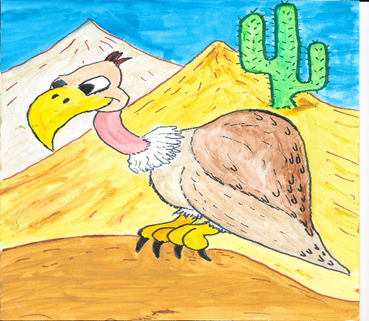
I'm writing this ABC book for my 12 year-old grandson, Eric. I've found many interesting facts of all the animals I've featured, and I hope children of all ages, 9 -109 will enjoy them, too. Thank you for reading todays letter, V.
V is for Vulture
When we talk about the vulture
a picture comes to mind,
its ugly face and bare long neck;
the fact is, that’s unkind.
Most won’t go near live animals,
to make a kill or maim;
but they’ll be there to clean the land
once death has made its claim.
Fun Facts on Vultures
The vulture is probably one of the only birds you really shouldn’t eat. Its diet, as we all know, is not going to give the meat the flavour we would enjoy. It’s chockablock with deadly bacteria. Plus, if you consider that no other animal, including other buzzards, would eat a dead vulture, it’s clear that it wouldn’t do us any good, either.
Nature knows what each of us needs to survive, and for vultures, it is a bald head and neck so that they can push their head right inside the carcass without worrying about getting their feathers messed up! Who of us would disagree with this? We all hate bad hair days! The only thing they have to do is have a quick clean-up once they’ve finished their meal.
Now, many would ask why do we need these horrible looking buzzards. Well, if we didn’t have them, we would have more diseases, leading to more deaths. These creatures are Earth’s cleaners, happily removing all the bad toxins dead animals leave behind. A vulture's stomach acid is so corrosive, it allows them to safely eat putrid carcasses infected with hog cholera; botulinum, which causes botulism, and anthrax bacteria. All of this is lethal even to other scavengers.
Kevinsphotos from Pixabay
*****
Back in the 1980s, there were more than eighty million white-rumped vultures in India until, for no reason that anyone could think of, they started dropping dead, literally in their millions. In fact, 95% of all the vultures died.
White Rumped Vulture
zoosnow from Pixabay
This gave rise to thousands of feral dogs and rats, carriers of rabies and other nasty diseases. Without the vultures to pick the dead animals' bones clean, the spread of lethal diseases increased to disastrous levels. More animals were left to rot in the fields, and others were contaminating the water supplies.
Years later scientists learned the vultures drastic death rate had been caused by the cows that had been given the anti-inflammatory drug diclofenac. This drug is highly poisonous to vultures who eat the carcasses. Chemists have now developed a new drug called meloxicam, a safe substitute that is not deadly to vultures.
*****
The New World vultures' are the most widespread, breeding from Canada to the southern tip of South America.
The turkey vultures don’t have a voice box, but they are able to make a hissing or grunting sound. They don’t build nests, either, but will find protected places, such as old hollow logs, caves, or abandoned buildings to lay their eggs. New World turkey vultures have an excellent sense of smell and can smell dead animals from a distance of one and a half miles.
*****
The Old World vultures range extends through the Sahel region of Africa. They are seen in the grasslands, mountains, and woodlands.
Old World Ruppell’s Griffon Vulture
Ruppell’s griffon vultures do have voice boxes. Although they are normally quiet, they become very noisy when at their nest, and squeal a great deal when eating. They are considered the highest-flying bird, with a verified flight altitude of thirty seven thousand feet above sea level.
These Old World vultures differ from their new world cousins because they do build their nests. They use sticks and leaves which are probably found in trees or on cliffs. Some will use the same nests for many years. While nesting, they will take turns to sit on it while their mate finds food.
*****
Another New World species is the common Black Vulture. This one breeds from southern North America to South America. The only other species of vulture in North America is the California condor, which is an endangered species on the very edge of extinction.
The black vultures are an aggressive species and will hunt and attack live animals as well as scavenge the dead. They are far stronger than the docile turkey vultures and will follow them until they have found a new food source and then shoo them off and keep their meal.
The black vultures have weak feet and blunt talons. Their beaks are long and hooked, ideal for tearing flesh. They have a wingspan of almost five feet and can live up to twenty-six years.
Extra Fun Facts
The word vulture comes from the Latin word vellere, which means to pluck or tear.
Turkey vultures incubate their eggs anywhere from twenty-eight to forty days. They care for the young in the nest for sixty to eighty-four days before they are ready to live on their own.
| Author Notes |
Thank you for reading my letter V for Vulture. Researching the vultures was quite revealing. I have now changed my opinion about them and will regard them with the respect they deserve.
Please let me know if you find the errors that hid from me, lol, they seem to do that a lot. This is written in UK English. :) |
![]()
By Sandra Stoner-Mitchell
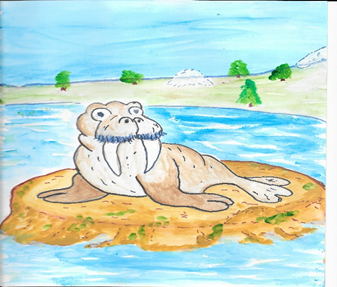
I'm writing this ABC book for my 12 year-old grandson, Eric. I've found many interesting facts of all the animals I've featured, and I hope children of all ages, 9 -109 will enjoy them, too. Thank you for reading today's letter, W.
W is for Walrus
They’re the giants of the Arctic,
Majestic in their size.
The ice cold ocean is their home.
So lusty are their cries.
Their tusks for anchorage
while sleeping in the sea,
and in this harsh part of the world,
their lives are wild and free.
Fun Facts on Walruses
Walruses are huge. Everyone knows that, but just how huge are they? They have a large amount of blubber just under their skin, about six inches thick, all around the neck and shoulders to keep them warm in the Arctic conditions they have to deal with throughout their lives. Adding to that their length of eleven feet, it is no surprise to discover they weigh in at around three thousand pounds. That is roughly the weight of a small car!
Walruses belong to the group of marine mammals that include seals and sea lions. These are called pinnipeds, which means they are fin or flipper-footed. They live in the ocean, but are able to stay on land for long periods of time.
Their skin is roughly four inches thick and very wrinkled around their necks and shoulders, making it much tougher for their two main predators, the polar bear and orca whales, to bite through. On top of all that, walruses have a thin covering of fur, but still look as if they’re bald. Another asset is their ability to slow their heartbeat, allowing them to live comfortably in the Arctic.
*****
When it comes to resting, walruses are unique. They can sleep for up to nineteen hours a day, or, at times, they’ll swim continuously for more than three days without a break. When they do want to sleep whilst in the water, they use their tusks as an anchor to hook them onto a rigid piece of ice. If that isn’t possible, they will swim over to the land.
*****
The walruses whiskers are highly sensitive due to them being attached to muscles that are supplied with blood and nerves. They use the whiskers to locate prey on the sea-bed. Once found, instead of using their tusks to dig them out, they squirt water through their noses to stir up the burrowing prey.
Walruses don’t chew their food, instead, they swallow it whole. An adult walrus can eat between three to six thousand clams in one sitting, but they do have a varied diet feeding on shrimp, crabs, tube worms, soft corals, tunicates, sea cucumbers, various mollusks, and even parts of other pinnipeds.
A Walrus hunting by cocoparisienne at pixabay.com
*****
Both the male and female walruses have tusks that can grow as long as thirty-six inches. These tusks are, in fact, canine teeth which continue to grow throughout their lives and can weigh several pounds. The length of these tusks have an important part to play in deciding which walrus will be the leader of the herd, also called a pod. The longer the tusk, the more respect that walrus will get. But, their power often comes to an abrupt end. Many fights break out between the male walruses. The leader can easily end up with broken tusks, thereby losing the respect of the herd.
Pushing their tusks into the ice to help pull their gigantic bodies out of the sea, is another important part the tusks play. It is now thought the Greek name for walruses, Odobenidae, meaning ‘one that walks with teeth,’ came about when they were spotted doing this. It does look that way, even though they don’t.
*****
When danger strikes, walruses can become formidable fighters. Polar bears are among the few predators capable of bringing these creatures down, yet even they tend to give fully-grown adult walruses a wide berth. They’ve been known to fatally wound polar bears.
Some Extra Facts
Gomphotaria pugnax walruses lived on the shores of present-day California roughly six million years ago. They had four tusks, two on the upper jaw and two on the lower.
The threat of climate change in the Arctic is a hazard to walruses and polar bears. As habitats shrink, ice-dependent species like walruses are moving onto the land. In 2014, around thirty-five thousand walruses hauled themselves out onto a stretch of beach in Point Lay, creating an extremely dangerous condition for their safety.
Walruses are easily spooked when crowded together; any sound, such as a plane or the smell of a predator, can cause a deadly stampede as they rush to get back into the ocean.
Recently, such a disturbance near Cape Schmidt, Russia, caused more than five hundred deaths, and many were young calves.
Some scientific projections suggest that the Arctic could be ice-free in the summers as early as 2040 -- only twenty short years away.
*****
Walruses are sensitive creatures. They have been seen keeping watch over injured walruses and pushing their dead or dying into the water so nearby hunters can’t get to them. Females have also been seen to carry their dead babies away from hunters.
The only pinniped larger than the walrus is the elephant seal. There has been one registered at a record-breaking, twenty-two feet three inches long, with a verified weight of 8,880 pounds. (4000 kg) I’m not sure I’d like it on my lap!
I hope you enjoy listening to the sounds the walrus makes. It's quite funny really.
| Author Notes |
If you come across any errors, I'd be most happy if you could tell me. Thank you!! This is written in UK English. xx |
![]()
By Sandra Stoner-Mitchell
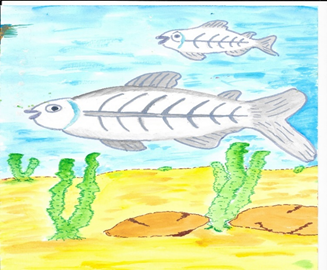
I'm writing this ABC book for my 12-year-old grandson, Eric. I've found many interesting facts of all the animals I've featured, and I hope children of all ages, 9 -109 will enjoy them, too. Thank you for reading today's letter, X.
X-ray-Tetra is a short piece because, as I’m sure you would realise, there is not much to learn about these little chappies.
X is for X-ray-Tetra
Transparent X-ray-Tetra fish
are difficult to find,
so they can hide from predators,
and all, but their own kind.
They don’t eat food that swims on by
since they like hunting for
crustaceans, worms and insects, that
live on the ocean floor.
Fun Facts on X-ray Tetra
The X-ray Tetra got their name from their see-through body. Not only can you see their bones, but also the eggs inside a female at breeding time. They can lay between three and four hundred eggs. They hatch within twenty-four hours, and the babies, called fry, start swimming around in just a few days.
They can be found in fresh water or the sea, and clear and salty water, too. This allows them to live in a variety of places, making them unique among other fish who can only survive in one area.
The transparent skin of the x-ray tetra helps them to blend in with the rocks and foliage. Their fins, though, are highly visible with yellow, white and black tips.
These little fish are also prized with having a Weberian apparatus. This is a structure that connects the swim bladder to the hearing system. The ‘swim bladder’ is an internal gas-filled organ that aids many bony fish to stay at their current water depth without wasting energy swimming.
Only fish that belong to the superorder ostariophysi have this device. This is a species with four frontal vertebrae joined together. They support a chain of small bones that connect the bladder with the ear. This gives them incredible hearing.
It is easy to identify the sex of x-ray tetra fish because the females are noticeably larger than the males.
The x-ray tetra feeds on insect larvae, worms and small crustaceans. They also enjoy some tasty sea-monkeys. Pictured below.
Although they have many natural predators, the greatest threat to the x-ray tetra is water pollution. This fish is capable of surviving in many different conditions, but those brought about by human interference make it much harder for them to deal with.
Because of their appearance, these little fish are very popular for aquariums. Because they are shoal fish, they are best kept in groups of eight to ten. They don’t mind being kept with other fish that are happy to have them in the same aquarium.
| Author Notes | This was very short. There isn't much to choose from for X. Although, there are some unpronounceable insects, but they had nothing of interest to write about. I hope you liked the one I did find. Thank you for reading. Two left to go! |
![]()
By Sandra Stoner-Mitchell
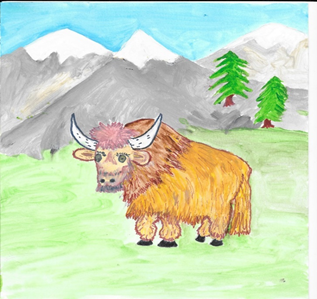
I'm writing this ABC book for my 12 year-old grandson, Eric. I've found many interesting facts of all the animals I've featured, and I hope children of all ages, 9 -109 will enjoy them, too. Thank you for reading today's letter, Y
.
Y is for the Yak
Domestic yaks are numerous--
the wild are in decline.
They live high in the mountain tops,
for them, the cold is fine.
Their shaggy hair is warm and thick,
to ease the freeze at night.
Their horns are long and very strong
to dig with and to fight.
Fun Facts on Yaks
In the Tibetan language, it’s the male of the species that’s called a yak. The female is called a dri or nak. Yaks are a friendly animal with hardly any recorded attacks against humans. However, the females are very selective about who they’ll allow to milk them. If you aren’t in favour, be warned, and don’t try!
Unable to use wood due to the lack of trees on the Tibetan plateau, the yak's dried dung provides the herders with the fuel they need for their fires ... and it’s plentiful.
There are two types of yak, the domesticated and the wild. It is believed the ancient Qiang herdsmen domesticated the yaks about ten thousand years ago. They now number at least twelve million. They were bred for their ability to move around the mountains in freezing weather. Their meat, milk, and warm fur skins are also very important to the herders.
Yaks are so sturdy and surefooted they are able to cross high mountains carrying incredibly heavy loads. They have been called the ‘boats of the plateau.’ Domesticated yaks are more active during the day and are used for plowing and threshing the hard ground.
They live in herds of around ten to twenty animals; usually these are the females with their young. In the winter, when the temperature plummets way below freezing, the herds huddle together to keep warm, with their young staying in the centre.
The male is more solitary, but many do form small bachelor herds. At the moment, there are no exact figures of how many wild yak there are in the world, but scientists believe there are between fifteen to twenty thousand, mostly living in the Northern Tibet Grassland.
Wild yaks are heavily built, and have strong bulky bodies, with sturdy legs and rounded, cloven hooves. Both male and female have long shaggy hair with a thick woolly undercoat.
Wild yaks are social animals that live in herds of up to several hundred, though many are much smaller. Mostly, herds have females and their young with few adult males. The females prefer to graze much higher up the mountain than the males, taking their young with them. Like the domestic yaks, the wild male prefers to stay alone or with other males. Although the wild yaks can be aggressive when defending their young, they like to stay away from humans and will run if approached.
The wild yak will mate with more than one female in a single breeding season, which is from July to September. Before this time, the solitary male will return to the herd. If more than one returns, they will fight for the right to mate with the females of their choice. Frightened or beaten yaks will then go off for a few days to graze, then come back to try again.
The females will usually produce one calf every two years. After about thirty-five weeks, the mother will find a quiet spot to give birth. Within ten minutes, the calf will be on its legs and walking, and then they’ll both return to the herd.
Yaks do enjoy a cold swim, they’re also happy in the freezing snow.
A few Extra Facts.
Yaks belong to the same animal family as the Asian Water Buffalo, the African Buffalo and the American Bison.
They are herbivores and munch on grass, flowers, moss and tubers.
Wild male yaks can reach a height of 6-1/2 feet and weigh as much as 2,200 pounds. Females are about 1/3 the size. The domesticated yaks are normally smaller than their wild cousins, weighing only 600 to 1,100 pounds.
Yaks have a different sound to other herds. As an example, cows produce a lowing mooing sound, and yaks make a series of grunts.
The wild yaks live to be around twenty years, while those in captivity live a little longer.
Yak herders not only drink the animals’ milk but also use it to make delicious butter and cheese.
Wild yaks are making a come-back after being almost wiped out by hunters in the middle of the 20th century. Listed as vulnerable, one step above endangered, they still have a way to go before being taken off the list.
| Author Notes |
Thank you so much for reading the letter Y. Pictures from Pixabay and Puplic Domain.com and of course, Graham's cartoon illustration at the top. :0)
If you find any nits, please let me know so that I can tread on them. This is written in UK English. |
![]()
By Sandra Stoner-Mitchell
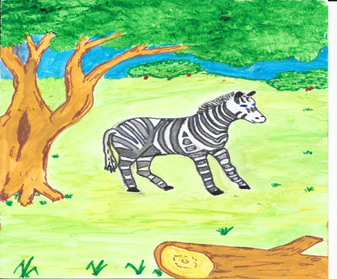
I'm writing this ABC book for my 12 year-old grandson, Eric. I've found many interesting facts of all the animals I've featured, and I hope children of all ages, 9 -109 will enjoy them, too. Thank you for reading the final letter, Z
Z is for Zebra,
Wild zebras live in Africa
where nature can be hard.
When sleeping, they’ll be standing up,
while some remain on guard.
When zebras rest they stand in groups,
the reason is, no doubt,
when all the stripes are muddled up
it’s hard to pick one out.
Fun Fact on Zebras
The stripes on zebras are like a human’s fingerprints, no two are the same. In fact, scientists have used the stripes in the same way we use bar codes, to easily identify the zebras they’re studying.
Zebras are mainly thought to have black or brown stripes on white skin, because the stripes stop at zebras' bellies, which are white. However, it is now known that zebras have black skin under their fine white hair coats!
There are three species of zebra still in existence: the plains zebra, the mountain zebra and the Grevy’s zebra, with many sub species. The plains zebra are the most common of the three types. They live in small groups of one stallion and several mares with their young. They can be found in the grasslands of eastern and southern Africa. Pregnancy lasts thirteen months before the foal is born.
The males that haven’t found their own herd will gather in a bachelor group. Some will try to take over another stallion’s herd, but they won’t find it easy. Even if it wins the battle, it still has to win the females' trust, which can take up to three years!
Stallions are males, of around 5-years-old, who have fought other males for the right to travel with that herd and mate with the females in the harem.
There are two different mountain zebras, the Equus (eekwes) zebra and the Hartmannae. They live in South-western Angola and South West Africa. They like dry, stony, mountainous areas. They prefer slopes and can be found as high as two thousand metres above sea level. They do come down in the winter season, though.
The mountain zebras have hard, sharp hooves to help them climb and keep their balance. They don’t have the mountain beard, but do have a strange neck flap called a dewlap, a bit like the turkey.
Hartmann’s zebra with dewlap. Pixabay
The Grevy’s zebra is the largest of the three species. Their stripes are usually narrower than the plains zebras. This species also has the largest ears, and the longest neck, which make them look almost mule-like.
The Grevy's common name comes from a royal gift. In 1882, Menelik 11 was the emperor of Abyssinia, which today is Ethiopia. The emperor decided his local zebras were regal animals, and as a sign of his respect, he sent one to the president of France.
Grevy’s zebra with long ears. Pixabay
To tell species apart, it’s best to look at their rumps. In order below:
1) The Grant's broad black. 2) The Burchell's two-toned. 3) The Grevy's narrow, close-set.
Let me introduce you to the Zonkey! He is such a delight. His zebra mother fell in love with a donkey, and we were gifted with the Zedonks! And what a cutie he is. Another zebra fell in love with a horse! And we were gifted with the Zorse!
Here we have a picture of a very rare spotted zebra.
The Grevy’s zebra, unlike the plains zebra, which needs to drink every day, can go without water for five days.
Unlike almost every other animal, the zebras make many different sounds. The mountain zebras whinny like the horse, Grevy’s bray like donkeys, and the plains zebras bark like dogs! If a stallion becomes alarmed by approaching predators, it will squeal or make a snorting sound.
To help them in the wild, Zebras have been blessed with super hearing and eyesight. This helps them keep clear of hyenas, cheetahs, and other predators. They also pack a powerful kick, and can run up to 35 mph. Since speed is vital, a newborn foal is born with legs that are 75% the length of its mother's and is all set to run moments after birth.
A group is called a dazzle, a herd, or a zeal. When they are huddled together, the muddle of stripes makes it a lot harder for predators to single one out for a kill.
According to the IUCN's Red List of Threatened Species, the plains zebra is not endangered, while the mountain zebra is considered vulnerable, and the Grevy's zebra is endangered, due to drought and the loss of their natural habitats.
.
That’s it! The whole alphabet is now completed. Thank you all for your wonderful support, and help with finding my nits!
|
You've read it - now go back to FanStory.com to comment on each chapter and show your thanks to the author! |
![]()
| © Copyright 2015 Sandra Stoner-Mitchell All rights reserved. Sandra Stoner-Mitchell has granted FanStory.com, its affiliates and its syndicates non-exclusive rights to display this work. |
© 2015 FanStory.com, Inc. All Rights Reserved. Terms under which this service is provided to you. Privacy Statement